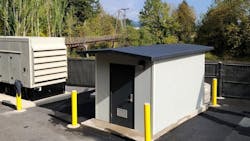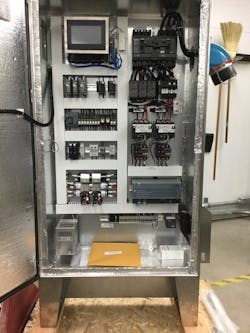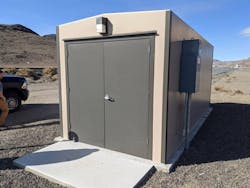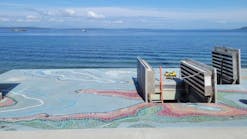Manufacturers have seen firsthand how a variety of customers design, specify, and install lift station buildings and controls. While the process is often complicated, we have helped them get the best value out of their investment by asking good questions so they can mitigate common pitfalls. In that process, we have discovered that the following steps are critical for the process to be as effective and efficient as possible:
- Determine required features;
- Evaluate site conditions;
- Determine construction considerations, ratings and standards required;
- Choose a reliable manufacturer;
- Evaluate manufacturing, shipping, and installation capabilities and timelines;
- Determine project scope, roles and responsibilities; And
- Evaluate life-cycle costs and value, including operation and maintenance requirements.
Determine Required Features
When specifying lift station buildings and controls, identify first the features required in the building itself, including materials and methods of construction, necessary components, and the aesthetics desired for the area where the lift station will be located.
Next, determine which controls features are necessary. For example, will remote monitoring and access be needed? Decide if easy web access on any device is necessary and make sure the system provides actual remote-control capabilities, if needed.
What about variable speed drives (VFDs), instead of starters, for improved efficiency? By using VFDs, pumps can be configured to run at the best efficiency point (BEP), unless there is extra demand, in which case they will operate at full speed. A VFD can also be used for phase conversion when the supply power is limited to single phase.
Which specific alarms are required? Alarms and alerts call out differently, so make sure to clearly outline what is needed. If custom alarms can be configured for specific situations, determine the urgency of each alarm condition.
Make sure the system is simple to operate and manage. Features like an intuitive, plain English menu; a start-up wizard or tutorial; and automatic default functions will make it easier for service personnel to keep the system running smoothly.
Evaluate Site Conditions
Next, evaluate what is needed for the building and controls based on where the lift station will be located. Is the proposed site large enough to accommodate the building? Is there an existing concrete pad? If so, is it suitable for the size of the structure being installed?
Then, identify the equipment that will go inside the building. Do not underestimate the space needed for the equipment. The cost of increasing building size from 1 foot to 2 feet is a minimal amount compared to the overall investment. The building is for the protection of the controls and drives, as well as providing a climate-controlled area for sensitive electronics, so make sure there is enough space that everything can be properly accommodated and protected. The building also provides protection for staff to work on sensitive equipment, regardless of weather conditions.
In addition to identifying what goes inside the building, evaluate what may be on the outside. Will there be power meters, disconnects, or communication antennas? What exterior color would be best to blend in with the surrounding area? How will that color react to local weather conditions?
If choosing to install a control panel alone (without a building), an enclosure that properly protects the controls will be required. Enclosures are UL-type rated for the location and application. Make sure it will be built to maintain the necessary rating with mounted devices. If the equipment will be under direct sun, evaluate whether a sun shield would eliminate the need for a cover. Will the environment be humid or potentially corrosive? If so, anti-condensation efforts will be necessary to prevent component failures. Composite enclosures and stainless-steel hinges and latches can be well-suited to protect controls from harsh environments.
Determine Construction Considerations, Ratings & Standards Required
Obviously, the building must be watertight, so the method of construction is a crucial consideration. Do the manufacturing and installation processes minimize the number of seams and connection points that could leak? How energy efficient does the building need to be, since that will affect the level of insulation specified? It is important to evaluate how much the building will cost over its entire lifetime. What is required for upkeep and maintenance? Is there a warranty? If so, what does it cover and for how long?
Where controls are concerned, what listing classifications are necessary? Examples include UL508A and UL698A listings for the U.S. and Canada and CE classifications for European markets.
A control panel inside a weather-tight building does not require weatherproofing. However, if the chosen a stand-alone panel and enclosure do not have a building to protect them, what rating classification is required? If the location is humid or corrosive, a stainless-steel type-4X enclosure may be required. Other requirements may include arc flash, separation of high voltage, specific or custom labeling, service entrance ratings, touch safe components and specific SCCR ratings.
Choose a Reliable Manufacturer
It is crucial to work with a reliable manufacturer. Ask them for references from previous customers with similar project specs. Do they offer a warranty? What kind of product support do they offer and for how long?
Make sure they have experienced engineers on hand who can value-engineer your project. Do they have a proven record of adherence to spec? Is their manufacturing facility state of the art? Do they use quality components and have a proven QA/QC program? How much on-hand inventory do they stock and what is their relationship with component suppliers? Can they package the building and controls to minimize site work? Ask about lead times, then confirm with previous customers that the manufacturer under consideration delivered the project on time and on budget.
Evaluate Manufacturing, Shipping & Installation Capabilities & Timelines
For a successful project, the manufacturer(s) involved need to coordinate from the beginning of the project. Submittals need to be timely and accurate. Manufacturers need to read the specs as written. Ideally, manufacturers can assist customers as they write their specs. Once received by the manufacturer, specs need to be carefully reviewed and responded to, because thoroughness is critical.
Where timelines are concerned, manufacturers have a lot of responsibility prior to installation. They need to commit to completion times for submittal packages and communicate effectively. Timely, thorough responses are critical to keeping a project on track. Delivery and installation timelines need to be clearly stated and updated, as needed.
The manufacturing process chosen determines the strength and durability of the final product. As mentioned above, aim to minimize the number of seams and connection points to make the structure more weather resistant. Integral walls and roofs can provide a watertight structure, and sound engineering is important in the design.
Installation can be simplified based on the site preparation, the materials chosen for the structure and controls, etc. A high-quality building can be installed in a matter of hours. It should be able to be attached to a concrete pad with minimal lifting and setting of the building. The pad must be level. Is the surface of the pad plus or minus 0.25 inches anywhere? A truly level surface will allow a high-quality building to be watertight, with no water intrusion under the walls, etc.
Consider the items that will be in the field and which items will be mounted on the walls. You should be able to attach equipment anywhere in the building. Using embedded wood for equipment mounting is a potential weak spot that could cause fiberglass to delaminate, diminishing long-term reliability.
Door location is also important. Where is the best door placement to facilitate necessary maintenance activities? Where is the best placement to access power and other items or services coming into the building?
Your lift station may need an HVAC system. What is being installed that generates heat? Can active ventilation keep the building cool? If not, does the building need an AC unit? A knowledgeable manufacturer can help with this assessment.
Determine Project Scope, Roles & Responsibilities
A lift station project brings together multiple participants and even more moving parts. All of these people and elements have to work together for the final results to be successful. How much of the work will be done by your internal staff? How much by outside contractors? What are your expectations of the manufacturer? Quality manufacturers have staff that will do structural calculations, mechanical layouts, and electrical design, along with scheduling tasks and timelines. Clearly outlining roles, responsibilities, and deliverables for each party is crucial. Managing all of these project participants is key to getting the right result and having it delivered on time and on budget.
Evaluate Life-Cycle Costs & Value, Including Operation & Maintenance Requirements
A lift station is a large investment. Building one is investing in the protection of critical equipment that operates a community’s wastewater collection facility. Doing so also invests in staff safety by providing a clean, safe environment for the controls they need to operate and the equipment they need to maintain. What is the best way to safeguard that investment, keep long-term costs as low as possible, and get the most value out of the lift station?
Consider operation and maintenance requirements. For buildings, what is the maintenance plan and schedule? For controls, does the manufacturer offer expert start-up help? Ask if this assistance includes a site visit.
Plan for appropriate expenditures now to extend the life of costly components and protect the investment. For example, the life cycle of the controls is extended if they are placed in a climate-controlled building.
Conclusion
If all these factors are taken into consideration together, they can make a huge difference in how a lift station is designed, manufactured and installed, and how the entire system functions over the long term.
By taking time to properly evaluate project goals, the system features needed, site conditions, construction considerations, life-cycle costs, and operation and maintenance, along with each manufacturer’s capabilities, one can set the stage for a successful project.
About the authors:
Darren Simmie is the sales director for Orenco Composites and is based in Oregon. He can be reached at [email protected]. Jerry Snyder is the sales director for Orenco Controls and is based in Texas. He can be reached at [email protected]. Heidi Bragg is editor-in-chief at Orenco Systems and can be reached at [email protected].




